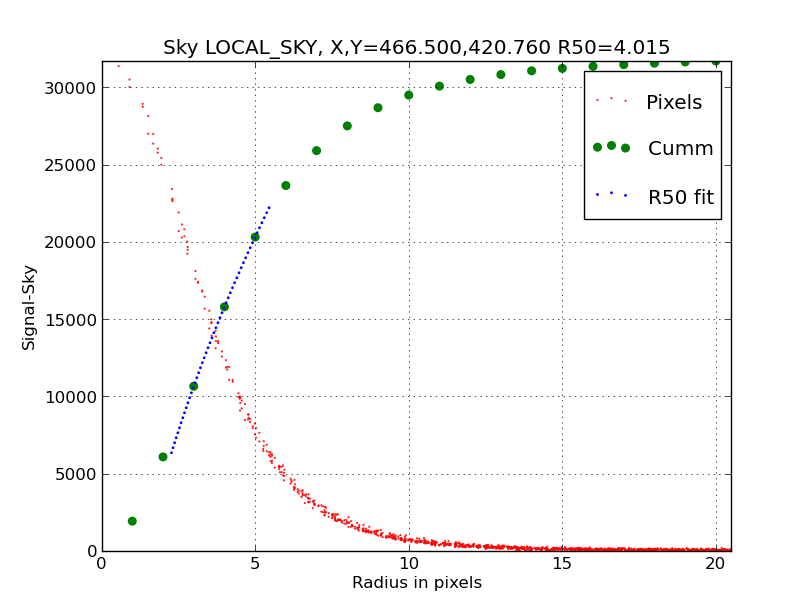ds9_profiles
Updated: May16,2020
This code is obsolete. A revised version
is ds9_profiles_x
Interactively generate and measure profiles in an image using a ds9 gui. It should be
stressed that this is a test bed code to aid in developing image analysis methods. It
is not meant for efficient batch-processing of numerous targets on an image. Rather, I
use this to create a variety of diagnistic statistics and graphics that clarify and
validate procedures like background estimation, profile extraction, and photometric
parameter (e.g. R50) estimation.
% ds9_profiles --help
# A typical call to ds9_profiles
% ds9_profiles Rsco2039.fits default default none N
This code was begun in Oct2015, and was substantially revised in Oct2018. It
has a dedicated matplotlib plot package, but much of the Oct2018 work was
dedicated to creating a set of uniformly produced table files (*.table and
*.parlab) that can be use to make a variety of plots with table-oriented
codes like xyplotter_auto.
Later I created dedicate packages for plotting profiles like
clip_margdist_sub_plotter and
profile_plotter.
- Sample data and exercises.
- Supporting routines.
Sample data and exercises.
You can access some sample images packed into a tarball VIA THIS LINK.
Below I show how I pacjed the tarball, how I can unpack it, and a brief description of the images.
% tar cvzf TestData.tar.gz Test_ds9_profiles # How I packed the data
% tar xvzf TestData.tar.gz # How I would unpack the data
The test images in ./Test_ds9_profiles/images:
Rsco2039.fits == R PFC image of the NGC3379 field. The imag is wcs- and zp-calibrated.
Useful for testing the ellipse and circle region use.
20181111T032020.1_056RL_flt.fits == bias subtracted LRS2 Qth image (flat lamp).
Useful for testing the box (horizontal) region use.
The OBJECT name for this image is "Qth_R", where the R indicates this was taken
through the red light guide. This test image was made with:
lrs2_bias_sub.sh /home/sco/LRS2_Nov15_Tests/Data_1/20181111T032020.1_056RL_flt.fits
20181115T044859.1_056RL_cmp.fits == bias subtracted LRS2 (arc lamp)
Useful for testing the box (vertical) region use.
The OBJECT name for this image is "Hg_R", where the R indicates this was taken
through the red light guide. This test image was made with:
lrs2_bias_sub.sh /home/sco/LRS2_Nov15_Tests/Data_1/20181115T044859.1_056RL_cmp.fits
20180403T075403.4_acm_sci_proc.fits == a typical acm image with a few stars. The image
was processed (ACM_reduced_gcprobes_Sep2018/) with a rough fixed bias pattern correction
and a wcs solution was installed in the header.
I will periodically add sample exercises to the list below.
- Exercise 1: Measuring an LRS2 arc lamp line.
- Exercise 2: A quick look at galaxy profiles (the NGC3379 field).
Supporting routines.
A number of routines were developed for ds9_profiles. I briefly review the most useful routines below.
# make radius image = pixels give radius within region
% ellradius.sh
arg1 - X dimension of output image
arg2 - Y dimension of output image
arg3 - X center in pixels
arg4 - Y center in pixels
arg5 - circle radius (asemi) in pixels
arg6 - axis ratio (b/a)
arg7 - PA in degrees (GALPHOT convention)
# Collect the profile points for a region using the radius image
% profile_pnts.sh
arg1 - name of fits image to be measured
arg2 - name of (fits) radius image (from ellradius.sh)
arg3 - sky value (fits image or fixed-number)
arg4 - pixel mask (can be "none")
arg5 - run in debug/verbose mode
# creates useful file: profile_pnts.table,parlab
# Compute the growth curve
% profile_gcurve.sh
Usage: profile_gcurve.sh profile_pnts.out 20.0 N
arg1 - name of input text file (profile_pnts.out)
arg2 - Maximum radius in pixel units
arg3 - run in debug/verbose mode
# creates useful file: profile_gcurve.table,parlab profile_gcurve_kfit.table,parlab
# Build a plot file
% profile_plot_01.py -h
usage: profile_plot_01.py [-h] [-v] arg1 arg2 arg3 arg4 arg5
positional arguments:
arg1 input data file
arg2 low value for X axis
arg3 high value for X axis
arg4 low value for Y axis
arg5 high value for Y axis
optional arguments:
-h, --help show this help message and exit
-v, --verbose Verbose responses
# creates useful file: As of Oct26,2018 user can opt for hardcopy with show()
The type of plot made with profile_plot_01.py may change, but an example from Oct26,2018
is shown below. The description in the figure caption should remain generally useful.
 |
|
A simple radial profile of a star measures on a 20180403 acm image.
The small red points are values from individual pixels collected with
the profile_pnts.sh routine, which uses a FITS image map of the target
radius balues (from ellradius.sh). Integration of this raw "profile"
is performed with profile_gcurve.sh, and the growth curve (also known
as the cummuuative distribution) from this code is plotted above as
green circles. The small blue points represent a polynomial ft to a
section of the growth curve around k=0.5 for the purpose of estimating
R50 (the "half-light" radius).
|
NEW FEATURE (Nov25,2018):
The profile data and plot files are archived to local subdirectories
with the name ap_*, where * is the region line number. The code used
for this is: ds9_profile_archive
Usage:
ds9_profile_archive 1 box N
ds9_profile_archive 2 ellipse N
Back
